Key Facts:
- Leishmaniasis Types:
- Visceral Leishmaniasis (VL): Also known as kala-azar, it’s fatal if untreated in over 95% of cases. Common in Brazil, East Africa, and India. Annual new cases: 50,000 to 90,000.
- Cutaneous Leishmaniasis (CL): Most common, causes skin lesions, mainly ulcers. 95% of cases in the Americas, Mediterranean, Middle East, and Central Asia. Estimated annual new cases: 600,000 to 1 million.
- Mucocutaneous Leishmaniasis: Affects mouth, nose, and throat. Over 90% of cases in Bolivia, Brazil, Ethiopia, and Peru.
- Transmission: Protozoan parasites transmitted by infected female phlebotomine sandflies. Over 90 sandfly species can transmit Leishmania parasites. Humans and 70 other animal species can be the parasite source.
- Global Impact:
- Estimated 700,000 to 1 million new cases annually.
- Visceral leishmaniasis has outbreak and mortality potential.
- Risk factors include poverty, malnutrition, population mobility, and environmental changes.
- Leishmaniasis-HIV coinfection reported in 45 countries.
Regional Specificities:
- WHO African Region:
- Cutaneous Leishmaniasis highly endemic in Algeria.
- East Africa faces frequent outbreaks of visceral leishmaniasis.
- WHO Region of the Americas:
- Brazil is the main country endemic for visceral leishmaniasis.
- Complex epidemiology with multiple sandfly types and Leishmania species.
- WHO Eastern Mediterranean Region:
- Accounts for 80% of cutaneous leishmaniasis cases globally.
- Visceral leishmaniasis highly endemic in Iraq, Somalia, Sudan, and Yemen.
- WHO European Region:
- Both cutaneous and visceral leishmaniasis are endemic.
- Common imported cases from Africa and the Americas.
- WHO South-East Asia Region:
- Visceral leishmaniasis is the main form of the disease.
Other Aspects:
- Post-kala-azar Dermal Leishmaniasis (PKDL):
- Sequel of visceral leishmaniasis.
- Appears as rash on face, upper arms, and trunk.
- Reported in Sudan, the Indian subcontinent, and Brazil.
- Leishmania-HIV Coinfection:
- High chances of developing the full-blown disease.
- Reported in 45 countries, with high rates in Brazil, Ethiopia, and Bihar (India).
- Antiretroviral treatment reduces disease development and increases survival.
Major Risk Factors:
- Socioeconomic Conditions:
- Poverty, poor housing, and sanitary conditions increase risk.
- Sandflies are attracted to crowded housing.
- Malnutrition:
- Diets lacking essential nutrients increase the risk of progression to the disease.
- Population Mobility:
- Epidemics occur when non-immune people move to high-transmission areas.
- Environmental and Climate Changes:
- Urbanization, deforestation, and climate change affect sandfly populations and disease spread.
Diagnosis and Treatment of Leishmaniasis
- Diagnosis based on clinical signs and parasitological or serological tests.
- Treatable and curable, but immunocompetence is crucial.
- WHO provides guidelines for diagnosis and treatment.
Leishmaniasis Prevention and Control:
- Early diagnosis and effective treatment are crucial.
- Vector control, disease surveillance, and controlling animal reservoir hosts are key.
- Prevention involves social mobilization, education, and partnership building.
WHO Response:
- WHO supports national programs, monitors trends, develops policies, and promotes research.
- Emphasis on early diagnosis, effective treatment, vector control, and social mobilization.
- Special initiatives for leishmaniasis-HIV coinfection and elimination in the South-East Asia Region.
Understanding and addressing leishmaniasis requires a multifaceted approach involving medical, environmental, and socioeconomic strategies.
